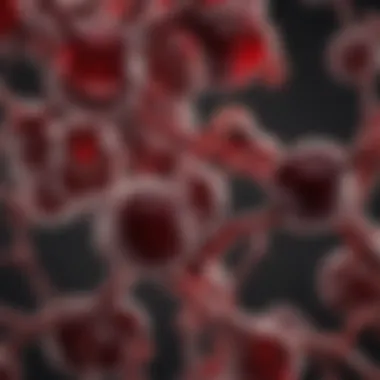Understanding Carbohydrates in Red Wine: A Comprehensive Exploration


Intro
The study of carbohydrates in red wine is essential for those seeking to appreciate its complexities. Carbohydrates significantly contribute to the overall body and flavor profile of wine. This exploration provides a detailed examination of their relevance, covering sugar sources, fermentation, and the consequences of carbohydrate content.
Understanding the types of carbohydrates in red wine, primarily sugars, gives insight into the fermentation process and how it affects the final product. Wine enthusiasts and casual drinkers alike can benefit from comprehending the nuances involved in red wine production, which ultimately impacts flavor, aroma, and health implications.
In the following sections, we will delve deeper into the origins and roles of carbohydrates in red wine. This will form a nuanced dialogue not only about taste but also about nutritional awareness concerning wine consumption.
Prologue to Carbohydrates in Red Wine
Carbohydrates are a vital component in the realm of red wine, influencing both its production and flavor profile. Understanding their role helps wine enthusiasts appreciate the complexity behind each glass. Carbohydrates significantly contribute to the mouthfeel, sweetness, and overall sensory experience of wine. This article aims to elucidate the various facets of carbohydrates, shedding light on their importance in winemaking and how they enhance consumer enjoyment.
Definition of Carbohydrates
Carbohydrates are organic compounds made of carbon, hydrogen, and oxygen. They exist primarily in two forms: simple and complex. Simple carbohydrates are sugars, often sweet and easily absorbed by the body, while complex carbohydrates consist of longer chains glucose molecules. In red wine, carbohydrates predominantly originate from the sugars found in grapes. These sugars are crucial for fermentation, where yeast converts them into alcohol and carbon dioxide.
The Role of Carbohydrates in Winemaking
Carbohydrates play a fundamental role in the winemaking process. Initially, during grape ripening, simple sugars like glucose and fructose accumulate in the fruit. These sugars not only provide sweetness but also determine the wine's potential alcohol content after fermentation.
During the fermentation process, naturally occurring yeast consumes these sugars, producing alcohol and various compounds that affect the flavor and aroma of the wine. However, not all sugars are fermented, resulting in residual sugars that can contribute to the sweetness of the final product.
This balance between fermented and residual sugars influences the overall taste and mouthfeel, creating a rich tapestry of flavors and aromas that define different red wines. Understanding these dynamics helps consumers choose wines that align with their personal preferences for sweetness and body, enhancing their overall wine experience.
Types of Carbohydrates Found in Red Wine
Carbohydrates in red wine form an essential aspect of its overall composition. Understanding the types of carbohydrates present provides insights into how they influence both the flavor and health implications of wine. These carbohydrates can be categorized into two main types: simple sugars and complex carbohydrates. Each type plays a unique role in the wine's attributes and contributes to the consumer experience.
Simple Sugars
Glucose
Glucose is one of the primary simple sugars found in red wine. This sugar is significant because it is readily fermentable. When yeast consumes glucose during fermentation, it produces alcohol and carbon dioxide. The presence of glucose directly affects the fermentation process, making it vital for winemaking. A key characteristic of glucose is its sweetness. This natural sweetness can enhance the overall flavor profile of the wine.
Glucose is often considered a beneficial choice in red wines because it can influence sweetness levels without overpowering other flavors. However, excessive glucose can lead to overly sweet wines, impacting drinkability. It is essential to balance its levels to achieve a desirable taste.
Fructose
Fructose is another simple sugar prominent in red wine. Like glucose, fructose is naturally occurring in grapes and is also fermentable. It provides sweetness but has a distinct sweetness profile compared to glucose. The unique feature of fructose is that it is absorbed more slowly by the body than glucose, which can be beneficial for those monitoring their blood sugar levels.
Fructose contributes to the complexity of the wine's flavor. It enhances certain fruity notes, offering depth. However, if present in high concentrations, it could also lead to excessive sweetness, altering the wine's balance. Understanding its role helps winemakers create wines with better flavor complexity.
Complex Carbohydrates
Polysaccharides
Polysaccharides are complex carbohydrates that contribute to the texture and mouthfeel of red wine. These compounds are not fully fermentable, meaning they remain in the wine after fermentation. A significant characteristic of polysaccharides is their ability to enhance mouthfeel. Wines with higher polysaccharide content often feel fuller and richer on the palate.
These carbohydrates can also affect the aging potential of wine. Polysaccharides have stabilizing effects, allowing wine to maintain its quality over time. They can also bind with tannins, softening their harshness and creating a smoother finish. This benefit underscores the importance of polysaccharides in crafting well-balanced wines.
Glycogen


Glycogen is a complex carbohydrate that serves as a form of energy storage for yeast during fermentation. While not abundant in red wine, its presence signifies a healthy fermentation process. A key aspect of glycogen is its role in yeast health and vitality.
Maintaining an adequate level of glycogen in the yeast ensures optimal fermentation. This functionality supports the development of desirable flavor profiles in wine. When fermentation is healthy, the resulting wine can exhibit balance and nuanced flavors. Therefore, glycogen, albeit less discussed, is crucial for a successful winemaking process.
Understanding the types of carbohydrates in red wine is essential for both consumers and winemakers. It shapes flavor, texture, and even health implications.
Sources of Carbohydrates in Red Wine
Understanding the sources of carbohydrates in red wine is essential to grasp the overall beverage experience. Carbohydrates influence not only the wine's flavor but also its texture and potentially its health aspects. In red wine, most carbohydrates originate mainly from grapes and are transformed during the fermentation process.
Grapes and Their Composition
The grape is the primary source of carbohydrates in red wine. Grapes contain various types of sugars, primarily glucose and fructose, which are naturally present. These sugars come from the grape's photosynthesis process, where sunlight, carbon dioxide, and water are converted into sugars. The balance between glucose and fructose can affect the sweetness and body of the wine produced.
Additionally, grapes also have complex carbohydrates such as polysaccharides. These polysaccharides contribute to the mouthfeel and help stabilize the color of the wine by interacting with tannins. The composition of grapes can vary significantly depending on the grape variety, ripeness at the time of harvest, and the region where they are grown. Ultimately, the quality of grapes directly impacts the carbohydrate content in the resulting wine, thereby affecting its overall taste profile.
Fermentation Process and Its Effects
The fermentation process is crucial for transforming grape sugars into alcohol. During this process, yeast consumes the sugars and converts them into ethanol and carbon dioxide. Not all sugars are fermented, which leaves specific residual sugars that influence the final carbohydrate composition of the wine. This residual sugar level plays a significant role in defining sweetness perception, which can range from bone dry to very sweet.
Further, the fermentation conditions, such as temperature and time, can affect how fermentation proceeds. Some winemakers may choose to halt fermentation early to retain more residual sugars, creating a sweeter wine style. Other winemakers allow full fermentation, leading to a more robust and drier wine. The choice of fermentation influences the overall carbohydrate content and its impact on flavor, sweetness, and health implications for the consumer.
It's important to note that different grape varieties and fermentation techniques can lead to diverse results, making each bottle of red wine unique in its carbohydrate profile.
Understanding these aspects can help wine enthusiasts appreciate how the sources of carbohydrates shape the characteristics of red wine.
Impact of Carbohydrates on Wine Characteristics
Carbohydrates play a significant role in determining various characteristics of red wine. Their presence influences not just the flavor and aroma, but also the overall mouthfeel and body. Understanding the impact of these carbohydrates enhances the appreciation of red wine and helps consumers make informed choices about their selections.
The relationship between carbohydrates and wine is complex, involving several factors. For instance, sugars can affect fermentation outcomes, while polysaccharides can enhance the texture of the wine. It is essential to explore these characteristics in detail to grasp how they contribute to the wine-drinking experience.
Flavor Profile and Sweetness Levels
Carbohydrates contribute deeply to a wine’s flavor profile and sweetness levels. Simple sugars like glucose and fructose are crucial here. During the fermentation process, yeast converts these sugars into alcohol, but the residual sugar left can define the wine's sweetness. The perception of sweetness in wine is not solely about the sugar content. It also involves acidity and other components. A wine with higher acidity can taste less sweet even if it contains significant residual sugars.
Some red wines, such as Port or certain Zinfandels, have higher sugar levels, leading to a pronounced sweetness. In contrast, drier wines like Cabernet Sauvignon or Merlot often retain minimal sugar. This balance creates a variety of taste experiences, from lush and fruity to sharp and robust. Different grapes bring unique sweetness profiles too, affecting their overall appeal to various palates.
In summary, the interplay between carbohydrates and acidity shapes how sweetness is perceived. Recognizing this can enhance a person’s knowledge when selecting a wine based on their preference for sweeter or drier options.
Mouthfeel and Body Structure
The mouthfeel of a wine relates closely to its carbohydrate content. Polysaccharides, which are more complex carbohydrates, influence the textural experience in the mouth. They can add body to the wine, making it feel fuller or more substantial. This can affect how the wine coats the palate, contributing to a longer finish and more lingering flavors.
A wine with rich polysaccharides will generally feel smoother and more velvety. On the other hand, a wine with lower carbohydrate levels might seem sharper or thinner. For instance, full-bodied red wines like Syrah or Malbec benefit from these complex sugars, enhancing their structural integrity.
Carbohydrates also have a role in the development of tannins, which interact to create a more integrated feeling in the mouth. This contributes significantly to the aging potential of the wine as well. Wines that have a good balance of carbohydrates and tannins tend to age better, evolving their mouthfeel and complexity as they mature. Understanding these elements allows wine enthusiasts to appreciate the nuances of mouthfeel and overall structure, guiding their choices in red wine selections.
Carbohydrates and Health Considerations
Carbohydrates in red wine have a significant impact on health, warranting thorough examination. Understanding the nutritional aspects of red wine, alongside its effects on blood sugar levels, helps consumers make informed decisions. While red wine is sometimes perceived solely as a pleasurable beverage, it is also a source of nutrients and liver benefits that deserve attention. This section will delve into the roles of carbohydrates in red wine, illuminating their potential health benefits and considerations.
Nutritional Aspects of Red Wine


Red wine contains several nutrients alongside carbohydrates, including vitamins and minerals. Key nutrients found in red wine include:
- Polyphenols: These antioxidants, specifically resveratrol, minimize oxidative stress, promoting heart health.
- Vitamins: Red wine provides some B vitamins, particularly B6 and folate, contributing to metabolic processes.
- Minerals: Elements like potassium and magnesium are present, assisting in various body functions.
The presence of these nutrients indicates that moderate consumption may offer specific health benefits, including cardiovascular advantages. However, it is essential to balance consumption with calories from carbohydrates and alcohol.
A point to consider is that consumers should be aware of the calorie content in red wine, as it can accumulate quickly. A standard glass of red wine may contain around 120 to 130 calories, depending on its sweetness and alcohol content. Maintaining a well-rounded diet alongside moderate wine consumption leads to better health outcomes.
Effects on Blood Sugar Levels
Blood sugar control is an important aspect of overall health, especially for those with diabetes or insulin sensitivity. Red wine's carbohydrate content, specifically its natural sugars, has some effects on blood sugar levels. Here are some insights:
- Natural sugars from grapes: These include glucose and fructose. While they do affect blood sugar, their overall impact is relatively modest compared to other sugary beverages.
- Polyphenols: Resveratrol and other polyphenols in red wine may help regulate blood sugar levels, improving insulin sensitivity over time.
"Moderate red wine consumption may positively influence blood sugar levels, possibly aiding in diabetes management."
It is essential to note that consuming red wine in moderation can contribute to a balanced lifestyle. The American Heart Association suggests up to one glass per day for women and up to two for men. However, excessive intake can lead to negative effects, such as increased blood sugar spikes or weight gain.
In summary, understanding carbohydrates in red wine offers insight into its nutritional content and health implications. Consumers should consider their individual health circumstances when enjoying red wine, leading to informed decisions about consumption.
Comparative Analysis of Red Wine and Other Alcoholic Beverages
The examination of carbohydrates in red wine cannot be complete without comparing it to other alcoholic beverages. This comparative analysis provides crucial insights into how red wine stacks up against other drinks like beer, cider, and spirits in terms of carbohydrate content and overall health implications. By understanding these differences, consumers can make informed choices based on their personal preference, dietary needs, and health goals.
Carbohydrate Content in Different Wine Types
Different types of wine exhibit varying levels of carbohydrates, largely due to the fermentation process and the specific grapes used. Red wine tends to have a higher carbohydrate content compared to white wine or sparkling wine. The primary source of carbohydrates in red wine is the residual sugars leftover after fermentation.
- Red Wines: On average, red wines like Cabernet Sauvignon and Merlot contain around 0.5 to 1.0 grams of carbohydrates per ounce. The specific grape variety, vineyard practices, and winemaking techniques determine the final carbohydrate levels.
- White Wines: White wines typically contain less residual sugar, often ranging 0.1 to 0.3 grams per ounce. Varieties like Chardonnay and Sauvignon Blanc showcase these lower carbohydrate levels.
- Sparkling Wines: Champagne and other sparkling wines can vary but generally have similar or lower carbohydrate content than red wine, influenced by temperature and fermentation details.
This diversity in carbohydrate composition across wine types highlights the significance of labels, as they provide necessary information on the composition, aiding consumers in their selection.
Red Wine Versus Beer
When comparing red wine to beer, the carbohydrate content and type vary significantly. Beer often contains more carbohydrates due to its base ingredients and fermentation processes.
- Carbohydrate Levels in Beer: Regular beers can contain between 10 to 15 grams of carbohydrates per 12-ounce serving, substantially more than red wine. Lighter beers may offer lower carbohydrate options but still generally exceed red wine's carb content.
- Nutritional Context: While red wine has additional health benefits such as antioxidants, the higher carbohydrate count in many beers can affect blood sugar levels differently.
In this context, understanding the carbohydrate composition empowers consumers to make informed decisions. Some may choose to indulge in red wine for taste and its potential health benefits, while others may opt for beer's varied styles and flavors.
"The choice between red wine and beer ultimately depends on individual preferences for flavor, dietary sensitivity to carbohydrates, and health considerations."
With this comparative perspective, one can appreciate not just the carbohydrate content but also the broader implications of beverage choices in relation to health and wellness.
Consumer Perception of Carbohydrates in Wine
Carbohydrates can shape not only the physical qualities of red wine, but also how consumers perceive them. The understanding of carbohydrates in wine empowers consumers to make educated choices, enhancing their tasting experiences and health considerations. As awareness grows about health and nutrition, the significance of carbohydrate content becomes ever clearer in the realm of wine. This section delves into current trends in healthy drinking and how they influence wine selection.
Trends in Healthy Drinking
The modern drinker is more informed than ever. People often associate carbohydrates with health risks, leading to a cautious approach toward alcoholic beverages. In red wine specifically, simple sugars might raise concerns regarding caloric intake and overall health impact. Studies showcase a shift toward lower-calorie and lower-sugar options, compelling wineries to adapt their offerings. Many consumers are now curious about carb content and how it compares to other beverages.
- Consumers are increasingly looking for transparency in labeling.
- Organic and natural wines are viewed more favorably, largely due to their perceived health benefits.
- Fitness enthusiasts may opt for wines with minimal residues from the fermentation process, seeking options low in residual sugars.


"Knowledge is key in navigating the wine market; understanding what goes into the bottle ensures better decisions for personal health."
Influence on Wine Selection
The selection process for red wine is not merely about taste anymore. Carbohydrate content has become a critical factor for consumers looking for specific health benefits or dietary compliance. This awareness extends beyond the wine store to restaurants and social settings.
As consumers evaluate wines, they consider:
- Carbohydrate levels: Low-carb options hold appeal for those monitoring their intake.
- Flavor variety: Choices often include inherent sweetness from grapes. Customers tend to favor wines that balance taste and health.
- Food pairings: Many understand how wine, as wholesome as it is, can fit into a nutritional plan when paired with food.
Emphasizing Responsible Wine Consumption
Responsible wine consumption is a significant aspect that contributes to the overall enjoyment and appreciation of red wine. It encompasses understanding one’s limits and the potential influences of wine on health and wellbeing. As consumers increasingly seek a balance between enjoyment and health, discussions around moderation, pairing strategies, and individual preferences become pivotal.
In this section, we explore crucial elements regarding responsible consumption. Firstly, the awareness of alcohol content in red wine is essential. Different types can have varying levels, influencing how much one should consume without adverse effects. Additionally, awareness of one’s body reaction to alcohol is vital. Each individual metabolizes alcohol differently, which necessitates tailoring consumption habits to personal comfort and health status.
Incorporating responsible drinking principles leads to various benefits:
- Health Preservation: Individuals can enjoy red wine while minimizing health risks associated with excessive alcohol consumption.
- Enhanced Tasting Experience: Drinking in moderation allows for better appreciation of flavors and aromas, preventing palate fatigue.
- Social Enjoyment: When individuals practice moderation, the social aspects of wine consumption can be more enjoyable and less prone to negative behaviors.
Ultimately, responsible consumption is not just about limits; it's about making informed choices that enhance the overall wine experience.
Understanding Moderation
Moderation is key to any pleasurable activity, and wine consumption is no exception. Defining moderation in the context of wine involves recognizing individual limits and setting them accordingly. Health experts suggest that moderate drinking typically means up to one glass per day for women and up to two glasses for men. However, these numbers can vary based on body weight, health conditions, and lifestyle.
Moreover, it’s not solely about the amount. The pace of drinking is also critical. Slowly sipping wine allows for flavor exploration and contributes to a more enjoyable experience. It gives time to savor each sip and appreciate the wine’s characteristics.
Being mindful of other factors, such as not drinking on an empty stomach, can further enhance the wine experience while maintaining moderation. Food can significantly slow the absorption of alcohol, making it easier to enjoy red wine responsibly without negative effects.
Pairing Wine with Food
Pairing wine with food is a fundamental aspect of culinary enjoyment that also promotes responsible consumption. The synergy between wine and food can enhance the flavors and textures of both. Proper pairings can lead to smaller portions of wine while simultaneously elevating the meal experience.
When considering pairings, a few guidelines can help:
- Balance Flavors: Match lighter wines with lighter dishes and robust wines with hearty meals.
- Consider the Sauce: The flavors in sauces can often dictate the best wine match, not just the main ingredient.
- Regional Pairing: Food and wine from the same region often complement each other well, as they evolve together within culinary traditions.
Engaging in thoughtful pairings can encourage moderation as well; by selecting complementary flavors and savoring smaller amounts, wine consumption becomes part of the meal rather than a standalone event. This practice cultivates a more responsible and enriching approach to enjoying red wine.
Epilogue
The exploration of carbohydrates in red wine is pivotal for several reasons. It not only sheds light on the composition of this popular beverage but also influences consumers’ choices and satisfaction. Understanding the carbohydrate content helps wine lovers appreciate the subtleties of flavor, sweetness, and mouthfeel associated with different wines.
Summary of Key Insights
In this article, we covered various facets of carbohydrates present in red wine. Here are some key insights:
- Carbohydrates mainly come from the grapes used in winemaking.
- Simple sugars like glucose and fructose contribute to the wine’s sweetness and overall flavor.
- Complex carbohydrates, including polysaccharides, enhance mouthfeel and add to the wine’s body.
- The fermentation process affects the final carbohydrate content, influencing both the taste and character of the wine.
- Greater awareness of nutritional aspects leads to informed consumption choices when enjoying red wine.
Collectively, these points highlight how carbohydrates are integral to red wine, affecting not just its taste but also the health implications linked to its consumption.
Future Insights on Wine Development
As the wine industry evolves, focusing on carbohydrate content opens avenues for innovation. Future developments may include:
- Enhanced fermentation techniques that could reduce unwanted sugars while preserving the desirable flavors associated with red wine.
- Research aimed at developing grape varieties that yield a better balance of carbohydrates, catering to health-conscious consumers.
- Increasing transparency in labeling to provide more clarity on carbohydrate content, enabling informed choices.
- Exploring how fermentation could be optimized to maintain or enhance flavor profiles while controlling sugar content.
Given these insights, the intersection of nutrition and viticulture is likely to play a crucial role in the future of wine making, ensuring that it meets the expectations of an increasingly discerning audience. Understanding carbohydrates in red wine not only enriches the drinking experience but also paves the way for more balanced and health-conscious enjoyment of this treasured beverage.







